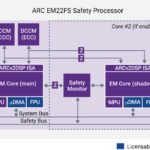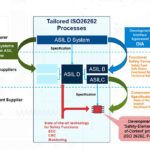 Synopsys, Inc. and Samsung Foundry announced the release of a validated automotive reference flow to streamline SoC hardware design for in-system test, implementation, verification, timing, and physical signoff for ISO 26262 compliance. This reference flow is targeted for automotive safety integrity level (ASIL) D autonomous driving and advanced driver-assistance systems (ADAS) applications. In close collaboration with Samsung, the optimized Synopsys automotive reference flow provides SoC architects, designers, and verification engineers with complete differentiated design and IP solutions that deliver complex functional safety (FuSa) analysis, implementation, and verification capabilities. The automotive reference flow utilizes Synopsys’ comprehensive automotive design flow and ASIL D-compliant functional safety processor IP.
Synopsys, Inc. and Samsung Foundry announced the release of a validated automotive reference flow to streamline SoC hardware design for in-system test, implementation, verification, timing, and physical signoff for ISO 26262 compliance. This reference flow is targeted for automotive safety integrity level (ASIL) D autonomous driving and advanced driver-assistance systems (ADAS) applications. In close collaboration with Samsung, the optimized Synopsys automotive reference flow provides SoC architects, designers, and verification engineers with complete differentiated design and IP solutions that deliver complex functional safety (FuSa) analysis, implementation, and verification capabilities. The automotive reference flow utilizes Synopsys’ comprehensive automotive design flow and ASIL D-compliant functional safety processor IP.
ISO 26262 compliance complicates predictable execution of the automotive SoC project, by necessitating manual time-consuming flows which lack scalability, incur significant work overhead, and consume limited machine resources. These challenges drive project managers and designers to adopt new methodologies to reduce resource requirements, minimize manual tasks, and improve the quality of results (QoR). Through close collaboration, Samsung Foundry and Synopsys delivered a comprehensive automotive reference flow optimized to provide the best possible productivity and QoR.
Synopsys’ comprehensive automotive design flow includes unified functional safety verification and native automotive solutions, enabling designers to prove at the planning and implementation phases that their chip safety architecture can achieve target ASILs. Designers can perform FMEA and FMEDA with best-in-class technologies for unified fault campaign management. As part of the shift-left approach introduced by Synopsys, early functional safety analysis at RTL or gate-level can quickly identify candidates for triple-mode redundancy (TMR) and dual-core lock-step (DCLS) redundancy and estimate metrics for target ASIL. Synopsys offers the industry’s first self-test solution instantiated directly into the RTL that tolerates indeterminate digital states while rapidly achieving high fault coverage. Synopsys’ native automotive solutions based on FuSa intent provide the industry’s most comprehensive feature set to implement FuSa mechanisms, such as TMR, DCLS, and Finite State Machine (FSM), perform formal verification, and check and report that safety mechanisms are properly implemented. Comprehensive digital/analog fault injection and simulation can be performed to produce reliable metrics for FMEDA and roll-up. Synopsys solutions are independently ISO 26262 certified to accelerate the deployment and qualification process for ASIL D designs.
The Synopsys functional safety processor integrates hardware safety features, such as redundant processors, error-correcting code (ECC), parity protection, safety monitors, and user-programmable windowed watchdog timers, to detect system errors. Comprehensive documentation related to safety, including enhanced-safety manuals, FMEDA, and design failure modes and effects analysis (DFMEA) reports accelerating SoC-level functional safety assessments. The processor is supported by Synopsys’ ASIL D-compliant toolkit, helping software developers accelerate the development of ISO 26262-compliant codes. In addition, Synopsys offers a broad portfolio of an automotive-grade interface, processor, and foundation IP that can help designers achieve high levels of functional safety, security, and reliability.



